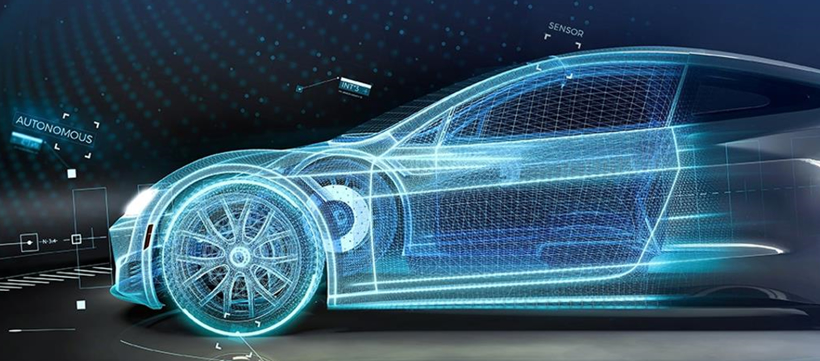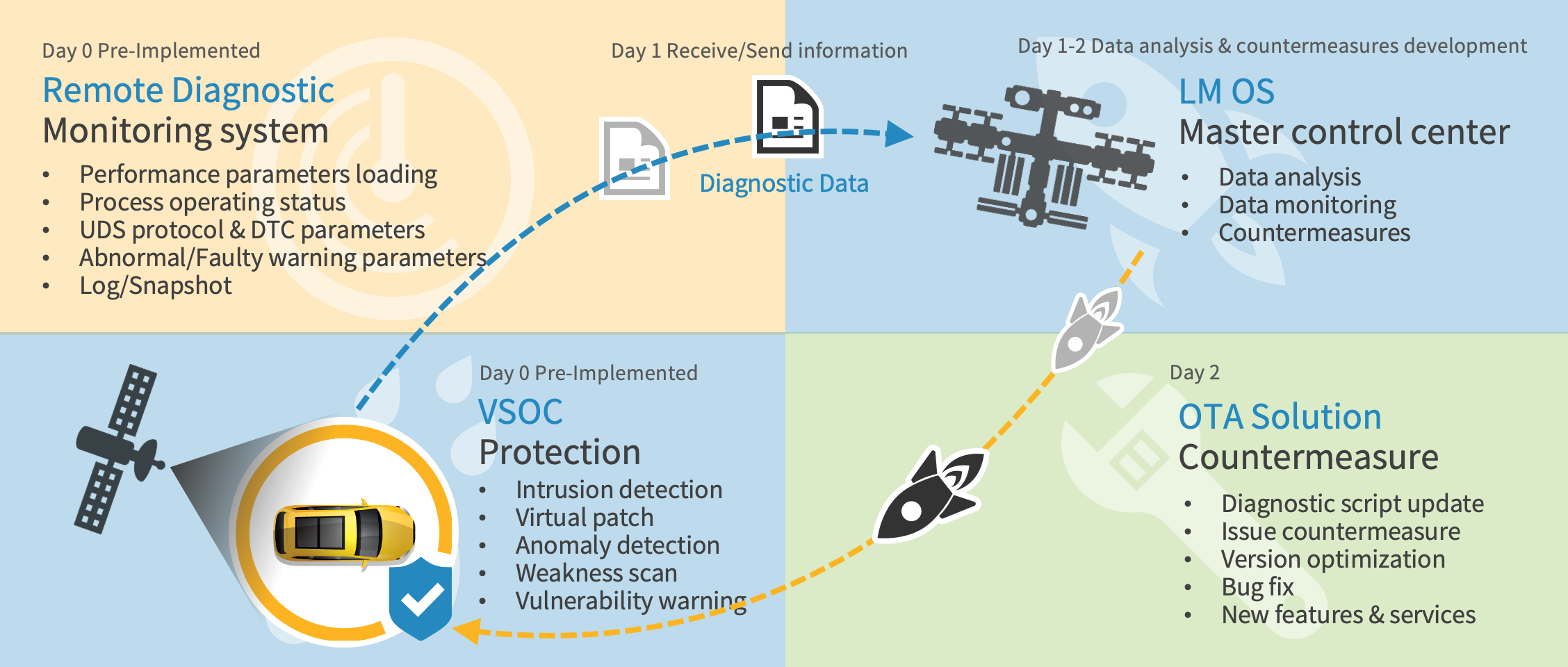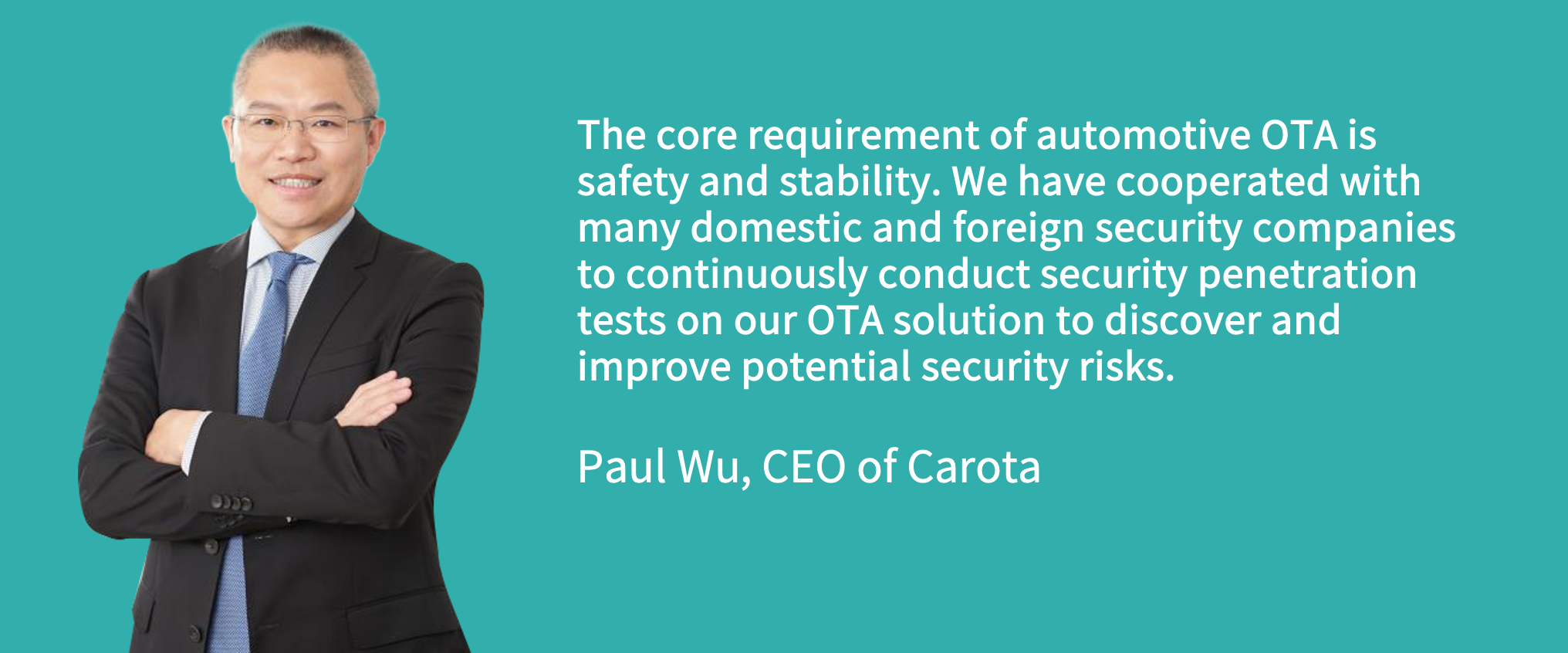With OTA empowerment, the vehicle remote diagnostics enters the era of intelligent
When it comes to OTA for automotive, a common perception is the addition of new features to the vehicle, in the same way as Tesla does. However, the range of possibilities is actually much wider. OTA is one of the main features for smart vehicles, and it can timely deliver a new driving experience and be used to diagnose and repair the vehicle’s faults, to ensure the vehicle’s safety through its life cycle.
The Carota security solutions for vehicles are based on OTA and Remote diagnostics to provide car manufacturers a comprehensive package with remote monitoring, remote diagnostics, early warning functions, data analysis, and OTA updates. In advance of malfunction, the potential risks are constantly monitored so the system issues can be updated and repaired via OTA.

Differences between traditional diagnostic and intelligent remote diagnostic
With traditional diagnosis, when an issue is found in the auto parts, the UDS protocol will save the fault information in its memory so the maintenance personnel can read it later via the communication bus. This method outlines a limited choice of location to proceed with the diagnosis, the necessity of a wire for the operation, and the fact that the vehicle has to return to the maintenance center for several days. Moreover, the diagnosis is limited to the DTC codes, and the data can only be obtained after the incident has occurred – by definition, it is a lagging indicator.
In comparison with the traditional diagnostics, the Carota remote diagnostic solution transforms the diagnosis from a passive to an active plan with the ability to remotely diagnose the vehicle, anytime and on a regular basis, and to remotely repair the faults (with the support of the OTA technology). Proactivity is remote diagnostic’s first quality. In case the user finds any abnormal conditions on the vehicle, he/she can vocally report it in order for the backend system to share its feedback via voice. Thanks to the vehicle’s assistance system, the driver can understand better about vehicle’s issues, and the car OEM can receive a detailed report of the vehicle’s condition, allowing more time for the appropriate repair.
Furthermore, when inspecting the vehicle’s breakdowns, a fixed location and a wire to diagnose the vehicle’s DTC codes are usually required. Once the issues have been found, the repair can only be done by returning the vehicle to a 4S shop or to the car’s manufacturer. With intelligent remote diagnostic, the diagnosis can be executed anytime and anywhere, as long as the vehicle is connected to the internet. Beside the DTC codes, other information such as the driving status, system load and abnormal events data can be diagnosed. The intelligent remote diagnostic is not only efficient but can also save maintenance costs.
“In the event that the cockpit system has a black screen, freeze, crash, or insufficient CPU performance issues, as well as faults related to the chassis system and ADAS; the OTA and remote diagnostic can be executed and deployed. The system will immediately notify the vehicle’s owner or OEM, allowing the car manufacturer to repair the faults or implement a recall when necessary, Jacky Chou pointed out. This means, that in addition to the SOTA upgrades for the in-vehicle infotainment system and autopilot software package, Carota can also support the automakers with FOTA for ADAS, autopilot, battery management, smart cockpits, power systems and braking systems equipment.
For these reasons, an increasingly number of automakers are actively building OTA and remote diagnostics capabilities. To list a few, SAIC Volkswagen, FAW-Volkswagen, Toyota, Great Wall, Geely, Chery, Dongfeng Liuzhou, etc., have established a close cooperation relationship with Carota. When adding partners in other fields, Carota cooperates with over 200 companies and has cumulatively upgraded 320 million devices through OTA. Carota can be described as one of the important enablers of smart connectivity for the Internet of Everything era.
From start to finish, the driving safety is empowered during the whole vehicle life cycle.
Remote diagnostics is not a new technology in the automotive field, however the outstanding feature of Carota’s solution is it can provide its clients professional OTA vehicle upgrades and intelligent remote control whether it is before, during or after a failure has occurred, and to ensure driving safety throughout the whole vehicle life cycle. The Carota’s solution can be divided into 4 components: Remote diagnostic + VSOC + LMOS + OTA. Among these, the remote diagnostic is mainly used to monitor the performance parameters loading, process operating status, UDS diagnostic protocol, fault warning parameters, etc. It interacts with an end-edge computing and diagnostic platform to assist the automakers in the discovery of system abnormalities. The Remote diagnostic and VSOC are implemented inside the vehicle at the factory site and is used to early predict the impending failures.

Carota on-board remote diagnosis solution
“Based on the dataset of warnings, behavior triggers, and conditions like the abnormal states accumulated in IVI script analysis, the system can analyze and estimate the actual condition of the vehicle by continuously collecting the status information such as communication networks, applications, hardware performance, operation records, system program to take precautions. We will conduct in-depth communication with the automotive companies regarding the alert settings such as how many times the abnormalities have occurred to be immediately treated. It should be noted that since remote diagnostic needs to collect a large amount of data, the platform will be setup at the vehicle factory site. When the system detects an ECU fault, it will immediately send the report to the vehicle manufacturer, enabling first car companies and technology providers to solve the issue sooner.” said Carota CTO, Jacky Zhang.
The Carota VSOC solution provides a network security protection. It includes, intrusion detection, issuance of virtual patches, anomaly detection, vulnerability scanning, vulnerability warning, and more. By cooperating with Trend Micro, Carota has a huge security database, automotive companies will be quickly notified to respond if an abnormal access is found.
The LMOS master control center is mainly used to analyze the collected data in the first two systems that provides decision-making basis for the next action of automotive companies and to assist in the formulation of OTA countermeasures. The essential work at this stage is to sort and classify the background data as well as to predict and evaluate it, then make these data as very important reference in the future. For example, how to discover diagnostic trends based on DTC rankings and occurrence trends, grasp vehicle status through interleaved analysis of models, ages, regions, and common problems. To that end, Carota has built a customizable service platform where automotive companies can collect multiple data and connect with third-party resources simultaneously.
Thereafter, Carota OTA update technology can be used to update the new versions of both software and firmware of each devices to achieve the effects of in-depth analysis, intelligent early warning, and remote optimization. In Carota’s perspective, this whole process can be continuously looped to continuously inject more optimized functions and experiences into vehicles and equipment, from monitoring and early warning analysis to remote update.

Carota Remote Diagnostic advantages
The Carota remote diagnostic solution can continuously monitor the vehicles’ status and help automotive companies profile their customers. For example, automotive companies can understand their users’ preferences by collecting the users’ hot zone date on function usage, to develop better smart cockpit applications. We can further analyze what kinds of driving behavior may cause some parts and ECUs more prone to problems by collecting the data of users’ driving behavior, in particular the frequency of abnormalities. In this way, it is possible to more effectively prevent special driving behaviors from particular drivers or to design future models and target design recommendations for specific group of users. From this perspective, the significance of OTA remote diagnostic to automotive companies is not only improve the vehicle’s safety during its whole life cycle, but also encourages automotive companies to optimize their market strategies and implement a better product positioning. It is worth mentioning that the current policy also affirms and supports the application of OTA in the automotive field. At the end of November, the China State Administration for Market Regulation issued a notice to further strengthen the supervision of the OTA technology recalls, which regulates the application of OTA in automobile recalls from multiple levels. Under the guidance of this policy, it is expected that in the future, an increased number of car companies will choose to deal with vehicle failures via OTA.

“ The core requirement of automotive OTA is safety and stability. In this regard, Carota has established an industry-leading OTA automated stress testing system. We have cooperated with many domestic and foreign security companies to continuously security penetration tests on OTA solutions to discover and improve potential security risks. At the same time, Carota has invested a lot of resources in research, develop and implement the remote intelligent diagnostic of automobiles to discover possible problems before users by transforming OTA from “disease treatment” to “disease prevention” solution.”emphasized Paul Wu, CEO of Carota.
Additionally, in response to the new policy, Paul said: “Carota will strengthen the security protection mechanism and development process, assess the introduction of international certificates, advocate the OTA upgrade regulatory requirements to OEMs, strengthen the construction of information security to increase the probabilities of preventing improper remote operation. Furthermore, Carota will make efforts in many aspects to improve the ecosystem and continue to play as a “enabler” for smart vehicle in the future such as cloud expansion and storage, smoothness and safety of pipeline, terminal and in-vehicle security center, vehicle-linked data and business middle platform, and Industry Development Analysis Platform, etc.

